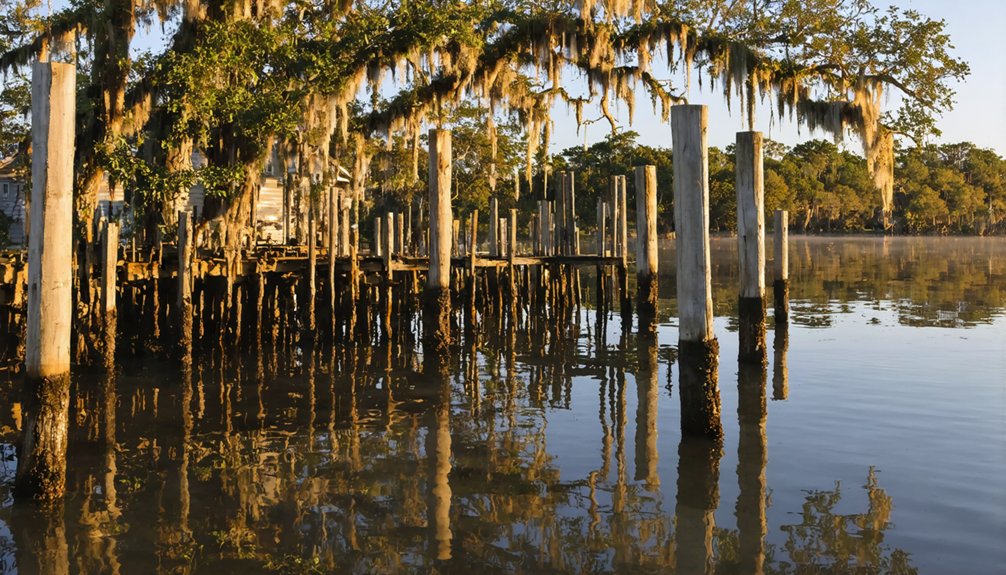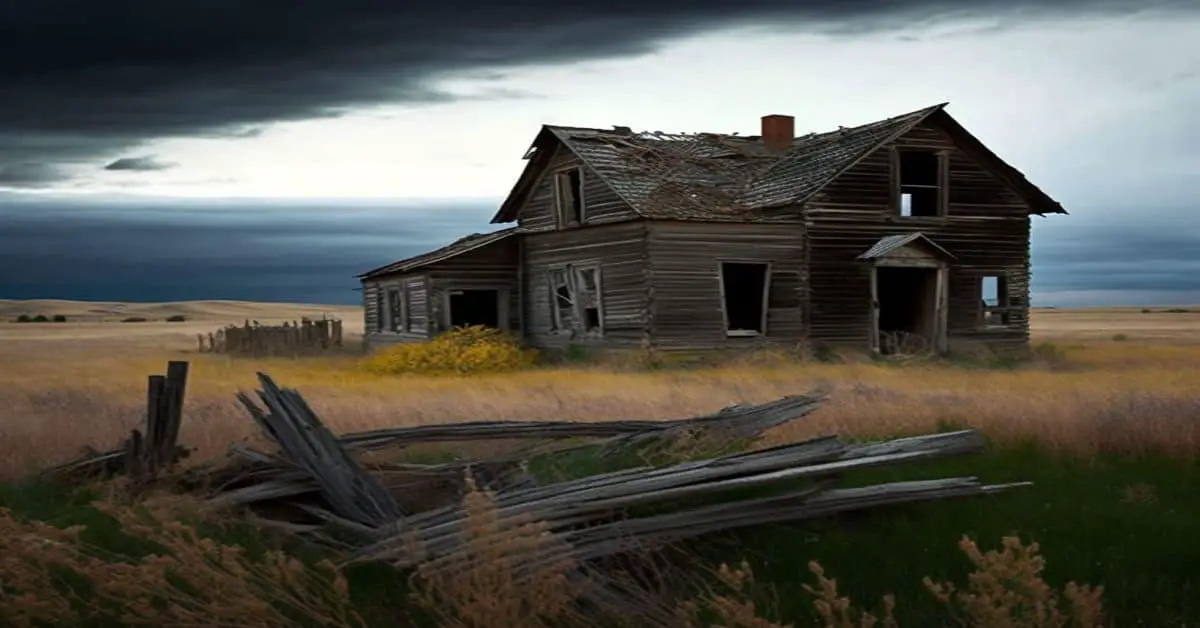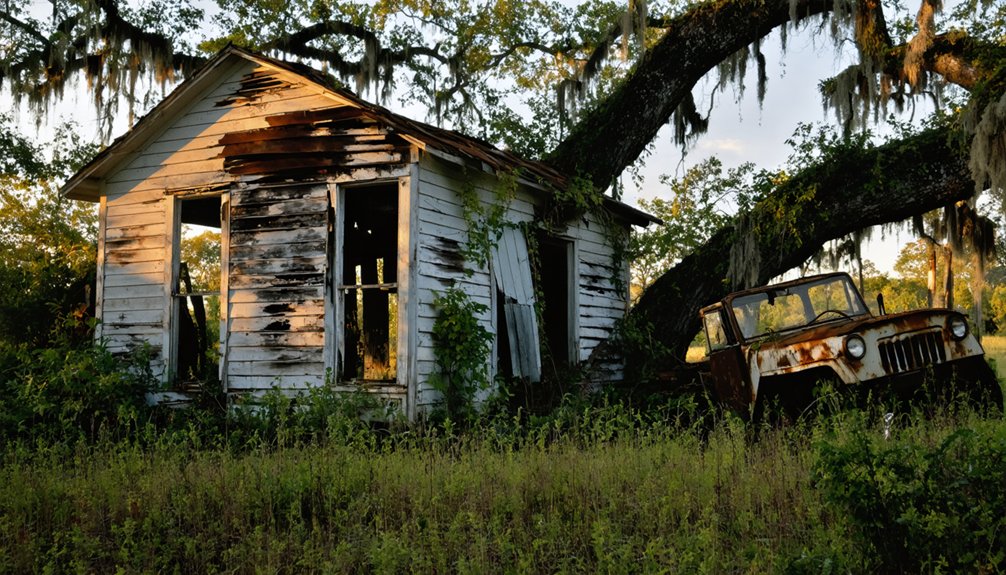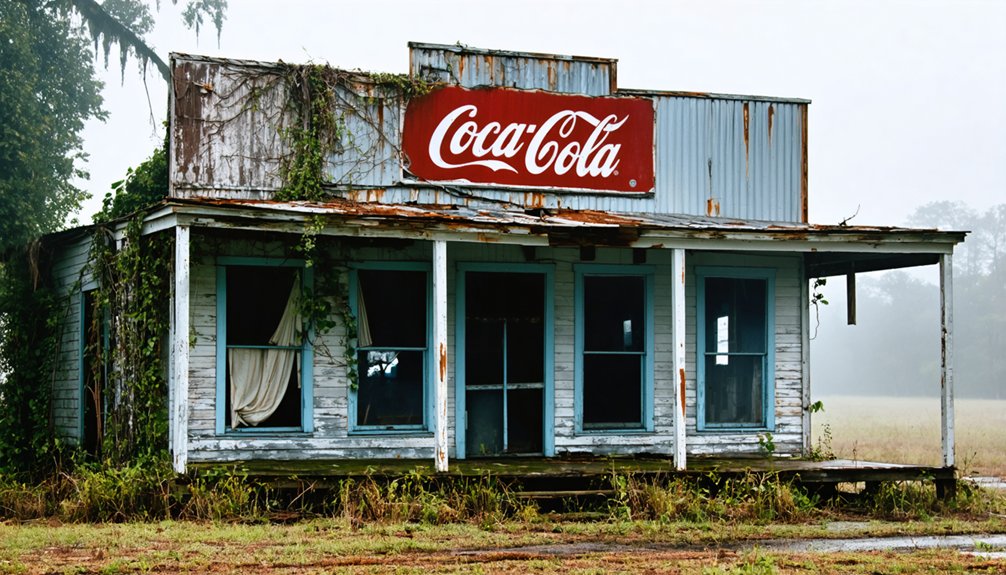You’ll find La Balize at the mouth of the Mississippi River, where French colonists established Louisiana’s first pilot station in 1699. This resilient community of river pilots and their families, which peaked at 800 residents, fought against nature’s fury for over 160 years. They built elevated wooden structures on piles above murky waters, rebuilding after numerous hurricanes until 1860, when a devastating storm finally forced their abandonment. The settlement’s remains now rest beneath the waters of the Balize Delta, holding untold stories of early Louisiana life.
Key Takeaways
- La Balize was a French settlement established in 1699 at the Mississippi River’s mouth, serving as a vital pilot station until 1860.
- The settlement reached 800 residents at its peak before becoming a ghost town due to devastating hurricanes and storm surges.
- Residents built elevated wooden structures on piles and used plank walkways to navigate the muddy wetlands and frequent flooding.
- The final destruction occurred in September 1860 when twin hurricanes obliterated the settlement, forcing complete abandonment.
- Though no longer on modern maps, La Balize’s legacy lives on through Pilottown and the name “Balize Delta.”
The Birth of a French Outpost (1699)
When Robert de La Salle claimed the Mississippi River Delta for France in 1682, he set in motion a chain of events that would lead to La Balize’s establishment in 1699.
La Salle’s 1682 claim of the Mississippi Delta laid the groundwork for La Balize, France’s strategic river outpost established seventeen years later.
You’ll find the origins of this strategic outpost at the mouth of the Mississippi River, where French colonizers built initial fortifications to control passage through two essential river forks.
They constructed a simple wooden fort and a lighthouse-type tower, establishing what would become an important checkpoint for ships heading to New Orleans.
The name “La Balize,” meaning “seamark,” reflected the settlement’s primary purpose as a navigational guide.
In 1721, the French enhanced the settlement’s navigational capabilities by building a 62-foot wooden pyramid.
As part of France’s broader colonization strategy, this remote outpost would serve as a gateway for the lucrative fur trade and other resources flowing through the Mississippi River system.
French engineers worked to improve river navigation by dragging an iron harrow through problematic sandbanks in 1726.
Life on the Delta’s Edge
You’d find daily life in La Balize dominated by the pilots’ perilous work of guiding vessels through treacherous river channels, often risking their lives for meager shares of the pilotage fees.
Living on the delta meant contending with devastating hurricanes and storm surges that repeatedly destroyed homes and buildings, forcing residents to rebuild multiple times between 1740 and 1860. The settlement was run by company slaves who endured harsh living conditions while maintaining operations in 1727.
The inhabitants adapted by constructing elevated wooden structures above the muddy wetlands, including their central tavern and the notable navigation pyramid that helped arriving ships find safe passage.
Daily Challenges of Pilots
Life for Mississippi Delta pilots demands exceptional skill and unwavering dedication, as they navigate through ever-shifting channels and treacherous waters near La Balize. You’ll need extensive pilot training to master the complex network of waterways, where sandbars and currents change without warning. Operating since colonial times, the demanding task of piloting vessels requires paying a substantial membership fee to join the Pilots Association.
Your navigation techniques must account for unpredictable weather patterns, storm surges, and powerful winds that can strike at any moment. Much like TACA Flight 737’s encounter with a level 4 thunderstorm, the Delta’s severe weather can create life-threatening situations that require quick thinking and expertise.
You’re facing isolation in remote pilot stations, surrounded by harsh swampland and dangerous wildlife. You’ll spend long periods away from family, living in basic quarters while maintaining your own facilities and equipment.
When storms approach, you’re often left to your own devices, as insurance companies won’t cover these high-risk areas. The job requires constant vigilance and self-reliance in one of America’s most challenging maritime environments.
Surviving Nature’s Wild Forces
Despite the French settlers’ strategic placement of La Balize in 1699, nature’s relentless forces dominated life at the Mississippi River’s mouth.
You’d have witnessed a community’s remarkable storm resilience as they rebuilt after each devastating blow, including the complete destruction of 1740 that forced relocation to San Carlos Island.
Life demanded constant coastal adaptation. When you lived in La Balize, you’d face flooding that could reach 10 feet high, making every storm season a battle for survival.
Francois-Xavier Martin documented the community’s struggles against violent weather patterns throughout Louisiana’s early history.
The twin hurricanes of 1860 proved especially brutal, with August’s surge followed by September’s fatal blow. You couldn’t escape the harsh reality: shifting waterways, treacherous currents, and repeated storm destruction made permanent settlement nearly impossible.
Like the Great Mississippi Flood of 1927 that would later devastate Louisiana, the delta’s waters showed no mercy to early settlements.
Building Above the Water
When French settlers first arrived at the Mississippi River’s mouth in 1699, they quickly learned that traditional building methods wouldn’t survive in the delta’s unstable environment. Their solution? A pioneering form of floating architecture that would define La Balize for generations.
You’d find every structure in the settlement perched on wooden piles, creating an elevated living environment that kept homes and buildings safely above the murky waters and shifting mud below.
The town’s infrastructure included narrow plank walkways connecting these stilted structures, as noted by explorer Friedrich Paul Wilhelm in the 1820s. Even the settlement’s first major structure, a 62-foot wooden lighthouse built in 1721, embraced this adaptive building style.
This innovative approach to construction became essential for survival as the delta’s landscape continuously evolved beneath the community’s feet. A hurricane in 1860 destroyed the original village, leading to the establishment of Pilottown as its replacement.
A Community of River Pilots
At the heart of La Balize’s existence stood the river pilots, who’d guide oceangoing vessels through the Mississippi Delta‘s treacherous maze of sandbars and shifting channels.
You’d find these skilled navigators living a precarious existence, boarding moving ships via rope ladders in dangerous weather while serving as critical advisors to foreign captains who relied on their expertise. The pilots worked tirelessly at this exchange point location, where Crescent Pilots would take over northbound vessels while Bar Pilots assumed control of southbound ships. In the 1860s, the pilot community relocated to establish what would become Pilottown, bringing with them their essential maritime expertise.
Their lives bridged two distinct worlds: the remote, rough-hewn community of wooden buildings on stilts where their families lived, and the steady stream of international merchant vessels they guided to and from the bustling port of New Orleans.
Throughout La Balize’s history, river pilots played an indispensable role in guiding oceangoing vessels through the Mississippi River Delta’s perilous waters.
Their pilot training demanded mastery of navigation techniques to handle the region’s notorious challenges:
- Shifting sandbars and multiple river mouths required constant vigilance and expert local knowledge
- Dangerous boarding procedures involved climbing 30-foot rope ladders in rough waters
- Coordination between Crescent and Bar Pilots guaranteed safe passage for ships moving up and down river
You’d find these skilled navigators expertly maneuvering ships through Southwest Pass, which became the main channel over time.
They’d overcome language barriers with foreign crews while setting ideal course and speed to avoid natural hazards.
Despite the treacherous conditions of the delta’s swampy environment, these pilots maintained essential maritime commerce flowing through one of America’s most significant waterways.
Life Between Two Worlds
Deep within Louisiana’s remote delta, La Balize emerged as a peculiar settlement where river pilots and their families carved out an existence between water and marsh.
You’d find their homes perched on wooden stilts, connected by precarious plank walkways above the muddy terrain. These hardy souls mastered river navigation, guiding ships through the Mississippi’s treacherous passages while building a unique cultural heritage in their isolated world.
In this community of roughly 100 residents, mostly men, life revolved around the rhythms of arriving vessels and the constant threat of storms.
The Catholic church’s presence provided spiritual anchor, though La Balize maintained its rough-and-tumble reputation. You’d witness a thriving economy built on piloting, fishing, and the occasional smuggling operation, all while residents faced the challenge of rebuilding after each devastating hurricane that swept through their vulnerable settlement.
Architecture in Hostile Waters
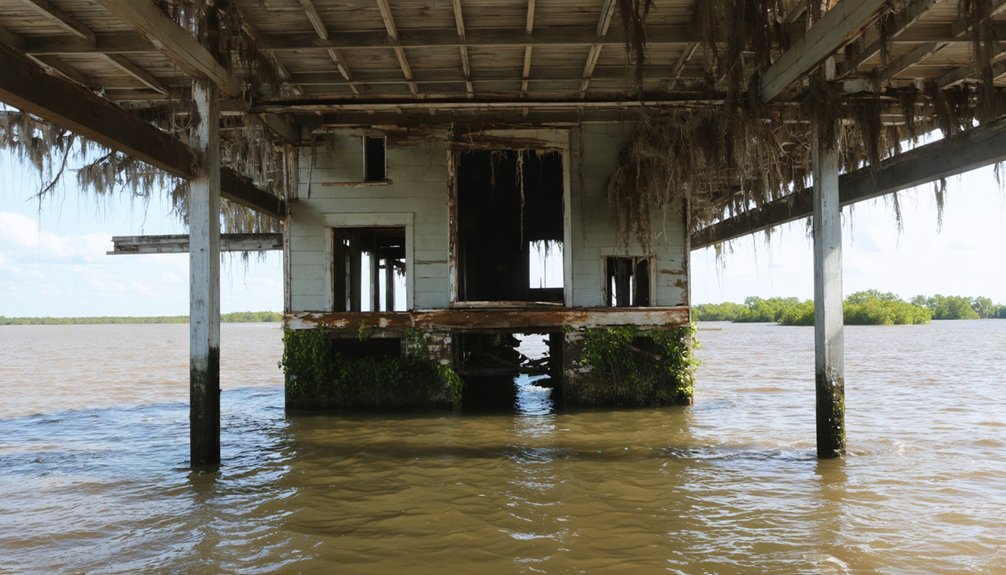
La Balize’s architecture evolved distinctly to survive one of North America’s most challenging coastal environments.
You’ll find that the settlement’s marshy architecture focused on wooden structures elevated above the delta’s unstable terrain.
The coastal resilience strategies included:
Early settlers mastered coastal survival through innovative building strategies, adapting their structures to harsh delta conditions.
- Houses and buildings raised on tall pilings, connected by plank walkways to keep residents above floodwaters
- A 62-foot wooden pyramid lighthouse that towered over the mudflats, guiding ships through treacherous waters
- Wooden forts and blockhouses designed for quick rebuilding after hurricanes
When storms struck, which they often did, the entire settlement would rebuild using readily available timber.
This practical approach to construction meant La Balize’s structures could be rapidly reconstructed, though they remained vulnerable to nature’s fierce assault on this precarious outpost.
The Battle Against Nature
Despite the ingenious architectural adaptations, nature waged a relentless war against La Balize’s existence. You’d find that hurricanes repeatedly struck the settlement, with the 1740 storm completely destroying the original French establishments.
While residents tried to show environmental resilience by relocating to higher ground and rebuilding, their efforts proved futile against the delta’s raw power. The settlement’s natural adaptations couldn’t overcome the deadly combination of storm surges and hurricane winds.
When a devastating hurricane hit in 1860, it spelled the end for La Balize. Five years later, in 1865, another storm destroyed what little remained.
The Mississippi Delta’s shifting sandbars, treacherous currents, and unstable marshlands had finally won their battle against human determination to maintain this strategic but vulnerable outpost.
Maritime Trade and Smuggling
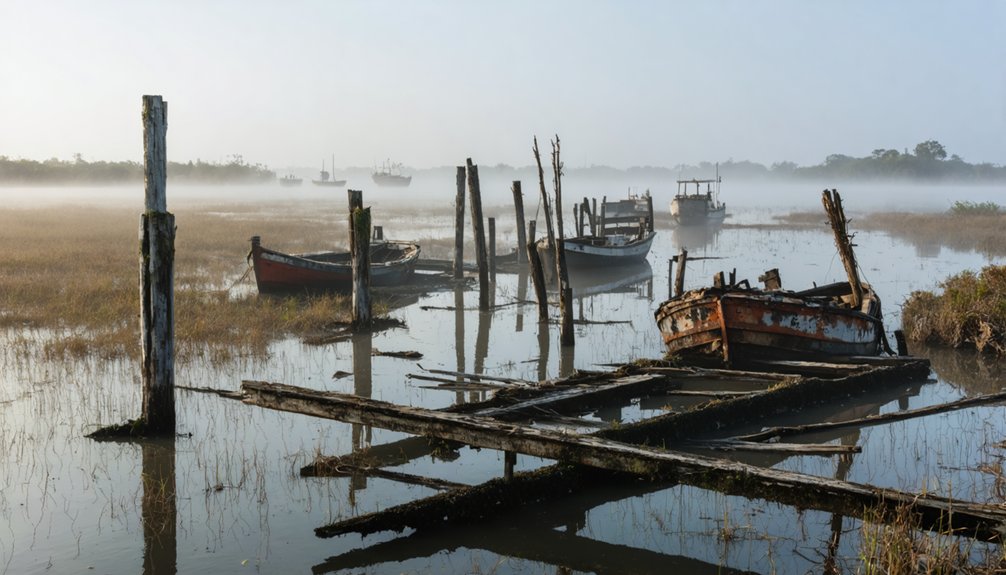
Strategically positioned at the Mississippi River’s mouth, the settlement played a pivotal role in controlling maritime commerce from 1699 onwards.
You’d find a 62-foot wooden pyramid serving as a lighthouse, guiding vessels through treacherous sandbars while French commissioners monitored trade routes and fought against smuggling networks.
To maintain control over maritime commerce, La Balize established:
- Professional river pilots who guided ships through dangerous delta channels
- Customs enforcement officers who inspected cargo and collected tariffs
- A “Garde Magazin” who managed the flow of goods
Despite the crown’s efforts to reduce export duties and encourage legal trade, smuggling remained persistent.
The settlement’s remote location and complex river navigation made it an attractive target for those seeking to bypass official channels, leading to continuous government intervention to maintain economic control.
Daily Life in Early Louisiana
Through a vibrant blend of cultures, daily life in 18th-century Louisiana emerged as a unique tapestry woven from French, African, Native American, and European immigrant traditions.
You’d find this cultural fusion reflected in every aspect of colonial life, from the raised French Colonial homes built to withstand floods to the distinctive Creole cooking that filled them.
In your daily routine, you’d enjoy a colonial diet rich in local ingredients – rice with milk, wild game, fresh oysters, and abundant fruits.
You’d live among a diverse population where young European indentured servants worked alongside enslaved Africans, while German and Swiss immigrants established their own communities.
Despite the sultry climate, wealthy residents maintained European fashion standards, though free Creole women pioneered more practical muslin clothing suited to the Gulf heat.
Hurricane’s Fury and Destruction
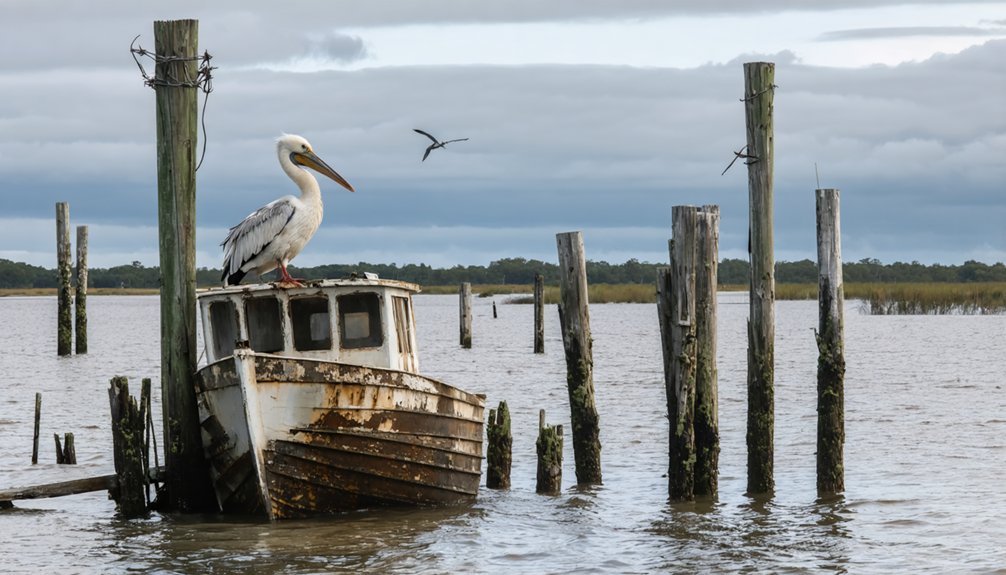
When violent storms repeatedly battered La Balize in the 18th and 19th centuries, the settlement’s fate was sealed by an unrelenting series of hurricanes.
You’ll find that hurricane impact was particularly devastating, with storm surges up to 10 feet destroying buildings, ships, and infrastructure. Coastal erosion and shifting geography made rebuilding efforts nearly impossible.
Major storms that shaped La Balize’s destiny include:
- The 1740 hurricane that wiped out the original settlement, forcing relocation to San Carlos Island
- The catastrophic 1778 storm that obliterated all establishments in the region
- Three devastating hurricanes in 1860 alone, bringing unprecedented destruction
After each disaster, the resilient community rebuilt, but nature’s fury proved relentless.
The Final Years of La Balize
You’ll find the last chapter of La Balize’s story marked by the devastating hurricanes of 1860, which finally forced its remaining 100 residents to abandon the struggling settlement.
The once-bustling maritime hub, which had maintained twice-weekly steamboat service from New Orleans until 1858, saw its river traffic diminish as storms repeatedly damaged its essential lighthouse and infrastructure.
Following the exodus, the river pilots established a new base at Pilottown five miles upriver, marking the end of La Balize’s century-long role as the gateway to the Mississippi River.
Hurricane Destruction and Relocation
During the mid-19th century, La Balize faced a series of devastating hurricanes that ultimately led to its abandonment. Despite attempts at hurricane resilience strategies, the settlement couldn’t withstand nature’s fury.
You’ll find the most destructive storms hit in:
- September 1855, destroying the lighthouse keeper’s house
- August 1860, bringing 10-foot storm surges
- September 1860, leading to the village’s final abandonment
The pilot community adaptations proved critical for survival, as they relocated about 5 miles upriver to establish Pilottown on higher, more stable ground.
This strategic move above the Head of the Passes guaranteed better protection from storms while maintaining essential river navigation services.
What was once a thriving community of 800 residents became a ghost town, with only a rusted iron tomb remaining by the early 20th century.
River Traffic Dwindles
As delta channels shifted and storms ravaged the coast, La Balize’s prominence as an important river traffic hub steadily declined through the mid-19th century.
You’d have witnessed the main ship passage changing location four times before 1888, making river navigation increasingly treacherous near the original settlement.
When a new channel cut through Cat Island in 1846, it altered traditional trade routes and forced pilots to adapt.
The Mississippi’s constant reshaping of the delta through sedimentation and erosion didn’t help matters.
You’ll find that commercial vessels began favoring upriver locations like Pilottown, where conditions proved more stable and predictable.
Pilottown Takes Over
The devastating twin hurricanes of September 1860 marked the final chapter for La Balize, forcing its remaining inhabitants to abandon the storm-ravaged settlement.
As river navigation shifted to the deeper Southwest Pass, a new community emerged about five miles above Head of Passes. You’ll find that Pilottown quickly established itself as the vital hub for river pilots, marking a cultural evolution in the Mississippi Delta’s maritime history.
The change brought significant alterations:
- The population dropped from La Balize’s 800 residents to a much smaller community
- A new pilot station emerged, built on piers in the swampy terrain
- The settlement became accessible only by boat or helicopter, creating an isolated but strategic outpost
This marked the beginning of Pilottown’s era as the important exchange point for river navigation through the complex delta passages.
A Settlement Lost to Time
Located at the mouth of the Mississippi River, La Balize emerged in 1699 as an essential French settlement that would face nature’s recurring wrath for over 160 years.
The river ecology shaped this rough-and-tumble community, where pilots, fishermen, and their families carved out a precarious existence amid the delta wetlands.
You won’t find La Balize on modern maps – its cultural heritage lies buried beneath the waters.
After countless cycles of destruction and rebuilding, including a major hurricane in 1740 that forced relocation to San Carlos Island, the settlement met its final fate in September 1860.
A devastating hurricane and storm surge wiped away this historic outpost, which had served as a critical navigation point since its founding.
Today, only the name “Balize Delta” remains, echoing the legacy of this resilient frontier community.
Frequently Asked Questions
What Indigenous Tribes Lived in the La Balize Area Before French Settlement?
You’ll find that the Quinapisa and Mugulasha tribes primarily inhabited the La Balize region, with influences from Choctaw heritage and Tunica culture spreading through trade networks before French arrival.
You’d see river pilots using pilot flags, signal rockets, and wooden beacons to guide your ship. They’d also wave banners from towers and send smaller vessels to meet you.
What Happened to the Residents After La Balize Was Abandoned?
You’ll find most displaced families relocated about five miles upriver to Pilottown, where historical records show they continued working as river pilots and fishermen in their new, more stable community.
Were There Any Famous Shipwrecks Near La Balize’s Waters?
You’ll find maritime legends like the Ville d’Archangel’s 1785 grounding with 303 Acadians and El Nuevo Constante’s 1766 hurricane wreck among nearly 300 documented shipwrecks in these treacherous waters.
What Crops or Gardens Could Survive in La Balize’s Harsh Environment?
You’d succeed with drought-resistant crops like rice and sugarcane, while salt-tolerant gardens of okra and sweet potatoes could thrive. Native marsh grasses and citrus would also adapt to coastal conditions.
References
- https://www.legendsofamerica.com/la-balize-louisiana/
- https://en.wikipedia.org/wiki/La_Balize
- https://kids.kiddle.co/La_Balize
- https://louisianagenealogygirl.wordpress.com/2018/01/20/a-lost-fort-on-the-louisiana-coast/
- https://www.louisianalife.com/life-at-the-end-of-the-road/
- https://nolatallship2.wordpress.com/2014/10/31/the-wickedest-place-in-louisiana/
- https://www.marinersmuseum.org/2018/07/a-duke-at-la-balize/
- https://en.wikipedia.org/wiki/Louisiana_(New_France)
- https://uncpressblog.com/2012/09/06/gordon-m-sayre-the-founding-of-new-orleans-a-city-of-floods/
- https://archives.uslhs.org/places/balize
